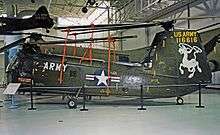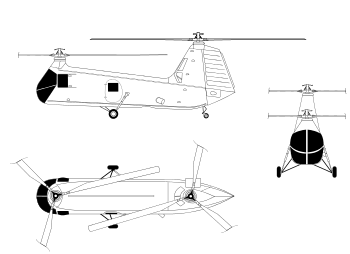Piasecki HUP Retriever
| H-25/HUP Retriever | |
|---|---|
 | |
| A U.S. Navy HUP-1 Retriever aboard the USS Midway (CVB-41) in the early 1950s | |
| Role | Utility helicopter |
| Manufacturer | Piasecki Helicopter |
| First flight | March 1948 |
| Introduction | 1949 |
| Retired | 1964 |
| Primary users | United States Navy United States Army Royal Canadian Navy French Navy |
| Number built | 339 |
|
| |
The Piasecki H-25 Army Mule/HUP Retriever was a compact single radial engine, twin overlapping tandem rotor utility helicopter developed by the Piasecki Helicopter Corporation of Morton, Pennsylvania during the late 1940s and produced during the early 1950s. The company changed its name in the 1956 to Vertol Aircraft Corporation and subsequently was bought by Boeing Aircraft Company in 1960, and became Boeing-Vertol.
Design and development
The design was a product of a competition by the U.S. Navy in 1945 for a compact utility/rescue helicopter to operate from ships including aircraft carriers, battleships, and cruisers. The prototype was designated as the XHJP-1, and first flew in March 1948. It was selected for production, as the HUP-1 in a side-by-side flight evaluation against the Sikorsky XHJS-1. It entered service with the navy in 1949.
Operational history


Versions of the HUP built for the U.S. Army were designated H-25 Army Mule. The tandem overlapping rotor configuration was a development by Piasecki and was used in future helicopter designs by the company and successors including the H-21, HRB-1/CH-46, and CH-47.
The design featured two three-bladed, 35-foot-diameter (11 m) rotors in tandem in which blades could be folded for storage. The HUPs were powered by a single Continental R975-46 radial engine, with a take-off rating of 550 hp (410 kW). To provide rescue without crew assistance, an electrically-operated door, available after folding the copilot’s seat forward, opened through which a rescue sling could be lowered from an overhead winch.
The HUP was produced for the navy in four versions: HUP-1, -2, and -3. The HUP-2 was the first production helicopter equipped with an auto-pilot. The US Navy also tested a system called 'Raydist that allowed an unmanned HUP-2 to be directed from a ground station and by radio ordered to hover within five feet of the desired point.[1] Edo tested a HUP-2 with a fiberglass hull and outrigger floats for amphibious operations.[2] In addition to those delivered to the U.S. Navy and Army the HUP/H-25 helicopter was also delivered to the Canadian and French Navies. A total of 339 aircraft were delivered over the 20-year life of the aircraft.
The US Army H-25 designation was adopted by the other services in 1962. The final units were withdrawn from US service in 1964. It also served with the French Navy from 1953 to 1965.
Variants
- XHJP-1
- First prototype, beat out Sikorsky S-53/XHJS-1 in competition for a shipboard utility helicopter. Piasecki-Vertol designation was PV-14[3]
- XHUP-1
- The first two pre-production examples. Piasecki-Vertol designation was PV-16.
- HUP-1
- Utility transport, search and rescue helicopter for the US Navy, powered by a 525 hp (391 kW) Continental R-975-34 piston engine. 32 built. Piasecki-Vertol designation was PV-18.
- HUP-2
- Improved version, powered by a 550 hp (410 kW) Continental R-975-46 piston engine. 165 built for the US Navy, 15 for French Aeronavale. Redesignated UH-25B in 1962.
- HUP-2S
- Anti-submarine warfare version of HUP-2 fitted with a dunking sonar. 12 built
- HUP-3
- Utility transport version powered by a 550 hp (410 kW) Continental R-975-46A piston engine. Similar to the H-25A, later redesignated UH-25C in 1962. 30 built, including 3 for the Royal Canadian Navy.
- H-25A Army Mule
- Utility transport helicopter for the US Army, powered by a 550 hp (410 kW) Continental R-975-46A piston engine, fitted with large doors, power-boosted controls and strengthened floors. Seventy were delivered from 1953, but they were unsuitable for front-line use, with 50 transferred to the navy from 1955, and the remaining helicopters used for training, being withdrawn from army service by 1958.[4]
- UH-25B
- HUP-2 redesignated after 1962.
- UH-25C
- HUP-3 redesignated after 1962.
Operators
Aircraft on display
- UH-25B Retriever 128479 on display at the American Helicopter Museum in West Chester, Pennsylvania.[7]
- UH-25B Retriever 128519 on display at the Intrepid Sea, Air & Space Museum in New York City, New York.[8]
- UH-25B Retriever 128596 on display at the Flying Leatherneck Aviation Museum in San Diego, California.[9]
- UH-25B Retriever 130059 on display at the USS Midway Museum in San Diego, California.[10]
- HUP-3 Retriever 147595 on display at the Pima Air & Space Museum in Tucson, Arizona.[11]
- HUP-3 Retriever 147600 on display at the Air Zoo in Kalamazoo, Michigan.[12]
- UH-25C Retriever 147607 on display at the National Naval Aviation Museum in Pensacola, Florida.[13]
- HUP-3 Retriever 147610 in storage at Yanks Air Museum in Chino, California.[14]
- HUP-3 Retriever 147628 on display at the Mid-America Air Museum in Liberal, Kansas.[15]
- HUP-3 Retriever RCN 622 on display at The Helicopter Museum in Weston-super-Mare, England.[16]
- H-25A Army Mule 51-16616 on display at the United States Army Aviation Museum in Fort Rucker, Alabama.[17]
- H-25A Army Mule 51-16621 on display at Shearwater Aviation Museum in Shearwater, Nova Scotia, Canada.[18]
- HUP-3 Retriever 51-16623 on display at the Canada Aviation and Space Museum in Ottawa, Ontario, Canada.[19][20]
- HUP-2 Retriever 128517 on display at the Wings of Freedom Aviation Museum in Horsham, Pennsylvania.[21]
Specifications (HUP-2)

Data from Jane's All The World's Aircraft 1956–57[22]
General characteristics
- Crew: 2 pilots
- Capacity: 4 passengers
- Length: 56 ft 11 in (17.35 m)
- Rotor diameter: 35 ft 0 in (10.67 m)
- Height: 13 ft 2 in (4.01 m)
- Disc area: 1,924 ft² (179 m²)
- Empty weight: 4132 lb (1874 kg)
- Loaded weight: 5750 lb (2608 kg)
- Max. takeoff weight: 6100 lb (2767 kg)
- Powerplant: 1 × Continental R-975-46A radial, 550 hp (410 kW)
Performance
- Maximum speed: 91 knots (105 mph, 169 km/h)
- Cruise speed: 70 knots (80 mph, 129 km/h)
- Range: 295 nmi (340 mi, 547 km)
- Service ceiling: 10,000 ft (3,050 m)
- Rate of climb: 1000 ft/min (5.01 m/s)
- Disc loading: 3 lb/ft² (15 kg/m²)
- Power/mass: 0.09 hp/lb (0.16 kW/kg)
See also
- Related development
- Aircraft of comparable role, configuration and era
References
- Notes
- ↑ "Radio Waves Hold Helicopter In Fixed Hovering Position" Popular Mechanics, May 1954, p. 122.
- ↑ "Picture News: Watertight hull makes helicopter amphibious". Popular Science. Vol. 172 no. 2. February 1958. p. 149.
- ↑ http://1000aircraftphotos.com/Contributions/WatkinsRay/8891.htm accessdate:26 January 2014
- ↑ Harding 1990, pp. 197–198.
- 1 2 3 4 "Piasecki H-25 History". Boeing. Retrieved 2013-02-02.
- ↑ "Piasecki PV-18 (HUP/H-25/UH-25) (Photo)". pictaero.com. Retrieved 2 February 2013.
- ↑ "Piasecki HUP Retriever/128479." aerialvisuals.ca Retrieved: 5 May 2016.
- ↑ "Piasecki HUP Retriever/128519." aerialvisuals.ca Retrieved: 5 May 2016.
- ↑ "Piasecki HUP Retriever/128596." aerialvisuals.ca Retrieved: 5 May 2016.
- ↑ "Piasecki HUP Retriever/130059." aerialvisuals.ca Retrieved: 5 May 2016.
- ↑ "Piasecki HUP Retriever/147595." aerialvisuals.ca Retrieved: 5 May 2016.
- ↑ "Piasecki HUP Retriever/147600". www.aerialvisuals.ca. Retrieved 2016-06-08.
- ↑ "Piasecki HUP Retriever/147607." aerialvisuals.ca Retrieved: 5 May 2016.
- ↑ "Piasecki HUP Retriever/147610." aerialvisuals.ca Retrieved: 5 May 2016.
- ↑ "Piasecki HUP Retriever/147628." aerialvisuals.ca Retrieved: 5 May 2016.
- ↑ "Piasecki HUP Retriever/622 RCN." aerialvisuals.ca Retrieved: 5 May 2016.
- ↑ "Piasecki HUP Retriever/51-16616." aerialvisuals.ca Retrieved: 5 May 2016.
- ↑ "Piasecki HUP Retriever/51-16621." aerialvisuals.ca Retrieved: 5 May 2016.
- ↑ "Piasecki HUP Retriever/51-16623." aerialvisuals.ca Retrieved: 5 May 2016.
- ↑ Canada Aviation and Space Museum. "Piasecki HUP-3". techno-science.ca. Retrieved 5 May 2016.
- ↑ "Piasecki HUP-2 "Retriever"". Wings of Freedom Aviation Museum. Retrieved 26 August 2016.
- ↑ Bridgman 1956, p. 345.
- Bibliography
- Bridgman, Leonard. Jane's All The World's Aircraft 1956–57. New York: The McGraw-Hill Book Company, 1956.
- Harding, Stephen. U.S. Army Aircraft Since 1947. Shrewsbury, UK:Airlife, 1990. ISBN 1-85310-102-8.
External links
| Wikimedia Commons has media related to Piasecki HUP Retriever. |